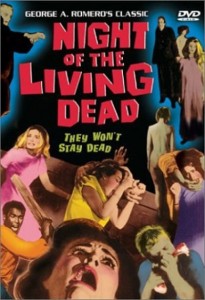 “Night of the Living Dead†is a horror movie of the most dangerous sort – the kind that attacks on a multitude of levels. Upon its release in 1968, the film received many different reactions, from standing ovations to stunned silences. The movie predates other classics of the genre, such as “Friday the 13th†(1980), “Alien†(1979), “Halloween†(1978), “The Texas Chain Saw Massacre†(1974) and even “The Exorcist†(1973). In spite of its age, “Night of the Living Dead†retains its power to shock. It was a revolutionary film for a revolutionary time, when the country was undergoing a drastic social upheaval.
“Night of the Living Dead†is a horror movie of the most dangerous sort – the kind that attacks on a multitude of levels. Upon its release in 1968, the film received many different reactions, from standing ovations to stunned silences. The movie predates other classics of the genre, such as “Friday the 13th†(1980), “Alien†(1979), “Halloween†(1978), “The Texas Chain Saw Massacre†(1974) and even “The Exorcist†(1973). In spite of its age, “Night of the Living Dead†retains its power to shock. It was a revolutionary film for a revolutionary time, when the country was undergoing a drastic social upheaval.
On April 4, 1968, George A. Romero, the director and co-writer of “Night of the Living Dead,†had been driving with Russell Streiner, one of the film’s producers. They were going to New York with a copy of “Night of the Living Dead†to sell the distribution rights.
That evening,they turned on the radio and heard the news that would forever change the civil rights movement – Dr. Martin Luther King, Jr. had been shot and killed in Memphis, Tennessee. When the news broke, Romero and Streiner knew their movie would have a stunning effect on audiences. “Night of the Living Dead†was more than another creature-feature with a shoestring budget, it was the first horror movie to cast a black actor in the lead. This was a new kind of movie – “Night of the Living Dead†was entirely different from anything any audience had experienced before.
“Night of the Living Dead†opens with a brother and sister (Judith O’Dea) in a cemetery, placing a wreath on their father’s grave. Suddenly, they’re attacked by strange man: The brother is killed, but his sister escapes and finds herself in an abandoned farmhouse. She discovers more strange people standing outside, their skin alarmingly decayed. Before long, another man (Duane Jones, the black actor I mentioned earlier) enters to escape them. After nailing barricades onto the doors and windows, they hear on the radio that the reanimated dead are attacking the living and devouring the flesh of the people they kill. Soon, they discover five other people hiding in the basement – a young couple, a husband (Karl Hardman), a wife and their daughter. The husband demands that they retreat to the basement for safety: The man upstairs argues that if the zombies break in, anyone in the basement won’t be able to escape, but the husband says it’s the safest place in the house.
George A. Romero wrote and directed three sequels to “Night of the Living Dead,†none of which managed to emulate the power of their predecessor: “Dawn of the Dead†was a close second, “Day of the Dead†and “Land of the Dead†were a distant third and fourth. Every time Romero returns to the genre he perfected, he works like a tired factory hand jostling in at the stroke of nine to operate tired machinery. Because “Night of the Living Dead†was Romero’s debut, he was determined to mark his arrival with a touchtone of modern horror. No audience had ever experienced a movie like this – the brutal slayings were far more graphic than other creature-features and concluded with an ending no Hollywood studio would ever shoot today. The films that followed became increasingly formulaic and lacked the uncompromising nerve of Romero’s original standard.
Although the power of “Night of the Living Dead†remains undiminished, several efforts have been made to improve on its success – it was remade in 1990 and reedited with new footage in 1998. It underwent innumerable colorizations and video transfers, most of which are poorly executed.
Research should be done before purchasing a copy – I recommend Romero’s definitive version on DVD from Elite Entertainment. Beware of recently modified versions of Romero’s other films, too – “Dawn of the Dead†was remade in 2004 and a sequel to “Day of the Dead†surfaced in 2005. They’re all pale imitations that carry the extreme familiarity of Romero’s original classic.
“Night of the Living Dead†is a two-fisted tale – one hand delivers a supernatural nightmare, the other hits us with a sobering critique on our culture. The characters are at war with themselves – their actions suggest that savagery is an inevitable condition of human nature. Romero’s comparisons between the living and the dead remind me of that line about men and pigs in George Orwell’s “Animal Farmâ€: “The creatures outside looked from pig to man, and from man to pig, and from pig to man again; but already it was impossible to say which was which.â€

Leave a Reply